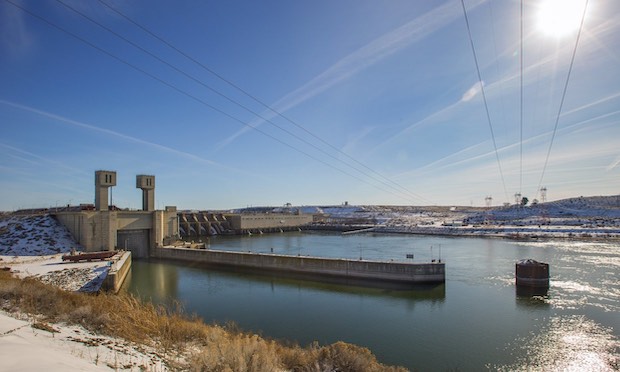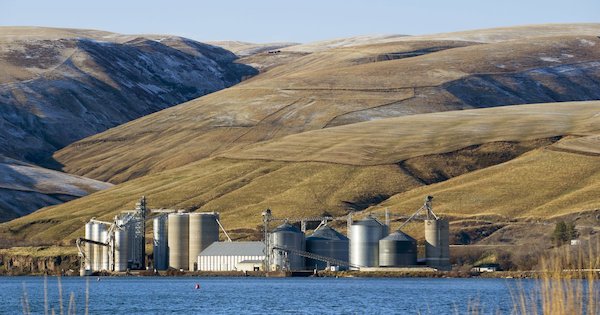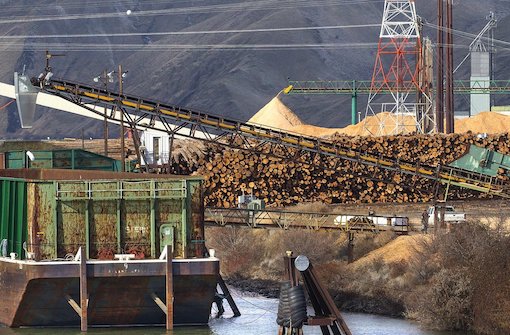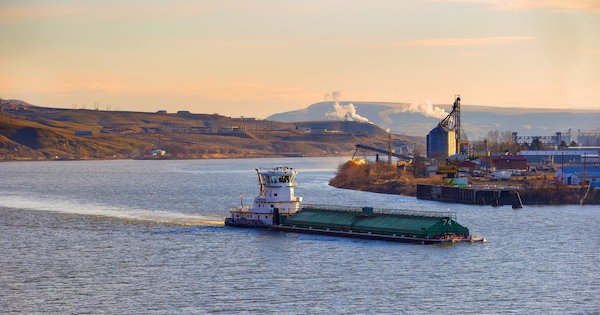forum
library
tutorial
contact

Breaching Snake River Dams Could Save
Salmon and Orcas, But Destroy Livelihoods
by Ron Judd
Pacific NW Magazine, March 21, 2019
|
the film forum library tutorial contact |

|
Breaching Snake River Dams Could Save
by Ron Judd
|
Folks whose jobs depend on four federal dams in southeastern Washington say that pleas
to breach the dams are forcing them to speak out in defense of their economy and their way of life.
 THE GROWING Snake River Dam people's self-defense movement has no written public-relations manual containing a list of cardinal sins. If it did, a new entry at the top might suggest this: DO NOT DISPARAGE THE ORCAS.
THE GROWING Snake River Dam people's self-defense movement has no written public-relations manual containing a list of cardinal sins. If it did, a new entry at the top might suggest this: DO NOT DISPARAGE THE ORCAS.
Not that anyone in Washington's southeast corner Breaching Snake River Dams Could Save Salmon and Orcas, But Destroy Livelihoods -- wheat country, USA Breaching Snake River Dams Could Save Salmon and Orcas, But Destroy Livelihoods -- would do that, anyway. Most of them will tell you that they, too, love chinook salmon, cherish orcas and see both as iconic Northwest species. They, too, know about the steady decline of the Salish Sea's southern resident killer whale population. They, too, watched that poor mother whale push her dead baby around for weeks last July. And they, too, grimaced over the orca's apparent grief.
"I would dare you to find anybody in this country who doesn't care about the salmon, or whales," says Tom Kammerzell, a lifelong Palouse resident, a Whitman County Port commissioner and Colfax highland cattle rancher who sports a central-casting ranchers' waxed mustache.
"It's important to all of us. It's part of our heritage."
But with that orca tale came newly impassioned calls to do something, anything Breaching Snake River Dams Could Save Salmon and Orcas, But Destroy Livelihoods -- everything Breaching Snake River Dams Could Save Salmon and Orcas, But Destroy Livelihoods -- to rescue these beautiful creatures that we, the people, God damn us all, have slowly poisoned and starved to death. Whatever it takes, said people who professed to be awake all night, weeping, over the whale's travails.
One predictable response was a newly impassioned call for the breaching of four federal dams on the lower Snake River, which for half a century have served as a powerhouse and water expressway for a huge chunk of the world's supply of wheat. It is here that red lines were crossed, guards went up, motives were questioned and a long-festering east-west Cascadia divide reignited flame-war fires all over social media and opinion pages.
When a state task force on orca survival called for a study widely seen as a means to justify dam breaching (ultimately a federal, not a state, decision), people from the Tri-Cities to Clarkston felt the metaphorical crosshairs trained once again on their backs.
While not new, it is a newly uncomfortable position Breaching Snake River Dams Could Save Salmon and Orcas, But Destroy Livelihoods -- one that has prompted the people of the lower Snake to issue a simple short-term request:
Whoa, pardners.
Whoa.
Just whoa.
 MANY DAM SUPPORTERS in the state's lower right-hand corner expected the breaching arguments, even acknowledge some of them. But after decades of defending a way of life centered on a pooled-up lower Snake River, they also view the emotional whale-warrior political pressure as the most serious existential threat, ever, to their own existence.
MANY DAM SUPPORTERS in the state's lower right-hand corner expected the breaching arguments, even acknowledge some of them. But after decades of defending a way of life centered on a pooled-up lower Snake River, they also view the emotional whale-warrior political pressure as the most serious existential threat, ever, to their own existence.
People here believe to their cores that a turbocharged rush to Free the Snake is fueled largely by fundamental ignorance by well-intentioned westsiders about what breaching the dams actually would mean.
Their message is simple: Those cursed dams Breaching Snake River Dams Could Save Salmon and Orcas, But Destroy Livelihoods -- often viewed just as 100-foot-high concrete monsters in a desolate, unpopulated landscape Breaching Snake River Dams Could Save Salmon and Orcas, But Destroy Livelihoods -- are connected by decades-old cultural and economic tendrils to actual living, breathing, soccer-playing, churchgoing, backyard-barbecuing, cherry-pit-spitting, binge-watching, beer-brewing, faithfully voting, mostly middle-class humans.
You know: people.
They're largely folks just trying to pay the rent. And this is something that might not be possible for as many as 15,000 Tri-Cities-area people in dependent jobs if the dams were breached. Thus, the mere thought of blowing up a primary local economic foundation, on what is broadly perceived as the off chance of saving a single pod of orcas, is viewed as somewhere between incomprehensible and flat-out crazy talk, mostly from self-appointed Facebook experts.
"I have never met a single human who has been here, and seen what goes on here, who thinks it (dam removal) is a good idea," says Steve Lee, a millennial cannabis entrepreneur who recently financed his own bid for a seat on the Kennewick City Council, where he is now mayor pro tem.
"Not one single person."
 THE FOUR DAMS on the lower Snake River Breaching Snake River Dams Could Save Salmon and Orcas, But Destroy Livelihoods -- from upstream to down, Lower Granite, Little Goose, Lower Monumental and Ice Harbor Breaching Snake River Dams Could Save Salmon and Orcas, But Destroy Livelihoods -- were authorized by Congress in 1945 and constructed between 1955 and 1975 by the U.S. Corps of Engineers. Another 11 dams exist on the Snake system upstream from Clarkston to the river's headwaters in Wyoming, providing irrigation water and small amounts of power. Unlike the lower dams, most of these contain no fish-passage facilities.
THE FOUR DAMS on the lower Snake River Breaching Snake River Dams Could Save Salmon and Orcas, But Destroy Livelihoods -- from upstream to down, Lower Granite, Little Goose, Lower Monumental and Ice Harbor Breaching Snake River Dams Could Save Salmon and Orcas, But Destroy Livelihoods -- were authorized by Congress in 1945 and constructed between 1955 and 1975 by the U.S. Corps of Engineers. Another 11 dams exist on the Snake system upstream from Clarkston to the river's headwaters in Wyoming, providing irrigation water and small amounts of power. Unlike the lower dams, most of these contain no fish-passage facilities.
The fight over the lower dams is not new. Environmentalists, backed by some native tribes, coastal salmon harvesters and deep-pockets greenies such as the Patagonia clothing company, have been agitating to Free the Snake for decades. Much of the fighting has been in courts, where a federal judge gave what once was considered a longshot movement new legs by suggesting a fresh look at breaching.
Amid the orca-survival drama, Gov. Jay Inslee has waded into the controversy, backing a $750,000 state study on dam removal that most eastsiders Breaching Snake River Dams Could Save Salmon and Orcas, But Destroy Livelihoods -- and their congressional representatives Breaching Snake River Dams Could Save Salmon and Orcas, But Destroy Livelihoods -- call a pointless state intrusion into a federal matter. It is a precarious political balancing act for Inslee, now running for president on a "green" platform Breaching Snake River Dams Could Save Salmon and Orcas, But Destroy Livelihoods -- but appearing, to many people in the Tri-Cities area he once represented in Congress, to favor replacing dams that provide a nearly carbon-free cargo transport system with thousands of smoke-belching trains and trucks.
A tipping point looms: A court-ordered environmental impact statement on the broader Columbia hydropower system's future is due in 2021. In the meantime, an agreement has been reached on a scheme to make the most of the Snake's fish-passage facilities, most considered state-of-the-art, by spilling more water over the dams.
The looming deadline has taken on new urgency thanks to the heartfelt efforts to save the southern resident orcas, which whale scientists say rely on struggling Snake River spring chinook, during annual coastal migrations, for critical sustenance.
But many Snake dwellers sense a disconnect between demands to breach the dams and the more-complicated facts of life in their own backyard.
Some will even concede key points made by dam opponents: The region would survive, energy-wise, without the four Snake dams, at least assuming only current energy needs and suppliers. Billions spent on salmon passage at the dams has improved the lot of salmon, but isn't likely to ever fully recover some stocks. And the Snake's status as a shipping superhighway is not as bustling as it once was.
But even to those granting all of that, the dams are still viewed as essential to their own survival and to the future vitality of a place where most residents have deep, well-watered roots.
Much of the argument over the dams has centered on hydropower. The four Snake dams currently produce about 1,000 average megawatts; hyrdro advocates like to call them a clean, on-demand "battery" that can keep the lights on to as many as 800,000 homes when wind or solar alternatives lag.
Most supporters acknowledge the dams wouldn't be built today, largely because of alternative power now available. But, well, here they are. The dams long ago established what successive generations have come to view as the normal landscape. Breaching them, they say, would be as dramatic to river residents as blowing out the Ballard Locks in Seattle and watching Lake Washington revert to its natural shoreline.
They also believe the dams, which could produce more power with (expensive) upgrades, are an important hedge against inevitable population growth in one of the nation's fastest-growing regions.
"We shouldn't just look at today," says Wanda Keefer, manager of the Port of Clarkston. "We need to look 20 to 30 years down the road."
 WHILE THE ENERGY necessity of the dams is debated, farmers focus on the dams' role as a mostly gravity-powered transportation system.
WHILE THE ENERGY necessity of the dams is debated, farmers focus on the dams' role as a mostly gravity-powered transportation system.
While moving goods 450 miles between Astoria, Oregon, and Lewiston, Idaho, barges pass through locks on eight dams on the Snake and lower Columbia. Snake River barge shipping has been in decline from a peak two decades ago, when barges moved some 9 million short tons of cargo per year. In the past decade, river shipping on the Snake has dropped from about 5.5 million short tons annually in 2007 to less than 3 million in the years immediately after the Great Recession. It has since settled between 3.5 million and 4.4 million tons per year.
Most of the drop was in movement of petroleum products and shipping containers. Wheat traffic has proved more stable; today it is 85 percent of the volume. The barge system, managed by Vancouver-based Tidewater, still moves more than half of the nation's grain, much of it to export markets. It remains a vital link for farmers along the lower Snake, who themselves grow as much as 10 percent of America's wheat.
"The Snake River and the Columbia is to us what I-90 and I-5 is to Western Washington," Kammerzell says. "This is our freeway to markets."
Some Palouse growers, given the emotions swirling over the whales, are beginning to wonder whether their old-school farmers' culture of conflict avoidance is a luxury they can still afford.
"We have suffered the consequences of not telling our story," Kammerzell says. "Our story is that we produce the greatest-quality wheat in the world, in the most productive wheat region in the world. But if we can't get that to market through a reliable transportation system, none of that matters."
Dam opponents suggest much of the region's wheat could, as it was in pre-dam days, still be moved by truck or train to Pasco, for shipping down the Columbia by rail or barge. But the environmental and financial costs, Kammerzell says, are rarely addressed.
Last month, he asked growers to pencil out figures: They're getting $6.50 per bushel for wheat, with a production cost of around $5 per bushel. It costs about 66 cents per bushel to barge the wheat downriver. At current rates for trucks or trains, that shipping cost leaps to an estimated $1.05 per bushel. The net profit after a dam breaching goes from 84 cents per bushel to 45 cents.
Cutting profits in half, Kammerzell warns, would force many farming families out of business. And he believes the real math might actually be worse: Past experience suggests rail operators would boost shipping rates exponentially if competition from barge lines were removed.
Kammerzell also says most dam opponents are ill-informed, but confesses impatience with those who seem willfully blind to impacts of breaching.
"These folks that are anti-dam and such, they must be anti-people," he says. "In all seriousness: They don't realize that this wheat is going out to other countries to feed people. We are feeding the world. If we can't do that, you're banishing these people to starvation. Are people less important than orcas?"
SO, YES. He went there. To many of his compatriots, this is the heart of the argument Breaching Snake River Dams Could Save Salmon and Orcas, But Destroy Livelihoods -- oft-thought, rarely expressed. Most people stick to discussing ways the present river system literally establishes the financial floor beneath them.
Out on the river one recent bone-chilling morning, Jim Fletcher, captain of the Tidewater towboat Granite Point, is deftly operating fingertip rudder controls on the behemoth, four-story-high, customized craft to push a grain barge into place at the Port of Wilma, across the Snake from Clarkston.
Fletcher has been running full "tows" of four barges each, up and down the Snake and lower Columbia, for 32 years. His father, river legend Scotty Fletcher, did the same thing for 50 years before that.
"Between him; my uncles; and my cousin, who's a port captain; and me, we have over 200 years here," Fletcher says.
As a kid growing up in Washougal, Fletcher would see his dad flash the house with a spotlight from the river, his mother responding by flashing the bathroom lights. It was the symbol, in pre-mobile phone or even CB radio days, that all was A-OK on the river.
"I'm probably one of the only guys you'll ever meet that knew what he was going to do when he was 3 or 4 years old," he says. "And I'm lucky it panned out that way."
 A Coast Guard veteran, Fletcher and his wife of 35 years, Kelly, have a daughter teaching high school, and a son with a WSU computer science degree. They own a home in the nearby Blue Mountains. The river, and its dams, has provided all of it.
A Coast Guard veteran, Fletcher and his wife of 35 years, Kelly, have a daughter teaching high school, and a son with a WSU computer science degree. They own a home in the nearby Blue Mountains. The river, and its dams, has provided all of it.
As he speaks, Fletcher nudges his 4,500-horsepower craft up against a 244-foot grain barge, which has drifted from its mooring at the Wilma grain-loading facility.
His towboats have moved just about everything imaginable in the flat waters beneath the craggy, ancient-floodwaters-carved faces of this river: wood pulp, for Costco toilet paper and high-end coffee filters, among other things; petroleum products, although the more hazardous heavy fuels have now been taken off the water; shipping containers, off and on. But grains, such as the current cargo Breaching Snake River Dams Could Save Salmon and Orcas, But Destroy Livelihoods -- soft white wheat, popular for making noodles Breaching Snake River Dams Could Save Salmon and Orcas, But Destroy Livelihoods -- are the mainstay.
A single "tow" of four barges moves 14,000 tons of wheat downstream. Each tow replaces 538 semi-trucks on highways, or 160 cars on congested Columbia Gorge rail lines. (An industry group says Snake River barges move the equivalent of 167,000 truckloads of goods annually; moving the Snake's wheat alone would require 137,000 trucks or nearly 24,000 additional rail cars.)
Fletcher can't fathom why anyone would want to replace his largely gravity-fed river system with tens of thousands of air-fouling trucks Breaching Snake River Dams Could Save Salmon and Orcas, But Destroy Livelihoods -- especially given heightened concern about carbon emissions, ocean acidification and climate change that threatens salmon runs and other marine life.
"We like to refer to it as a very small carbon footprint," Fletcher says. "In this day and age, most people want to hear that."
His company, Tidewater, has changed its operations significantly to accommodate fish passage and reduce risks of environmental damage, he says, and is proud of its record.
"We've made adjustments; we've done that," he says. But he wonders why society at large gets a free pass from making similar hard choices.
"What we have done is, we've decided to save everything," he says. "We save fish, but we also save sea lions, and save all the things that eat fish."
The solutions, he says, are above his pay grade. But some things just seem obvious.
 ACROSS THE RIVER from Fletcher's towboat, Wanda Keefer, from her office at the Port of Clarkston, throws another curveball through the dam-busters' strike zone.
ACROSS THE RIVER from Fletcher's towboat, Wanda Keefer, from her office at the Port of Clarkston, throws another curveball through the dam-busters' strike zone.
Gone with breaching would be one of the more promising local nonwheat enterprises: riverboat tourism. Unbeknown to many, four cruise lines operating six boats run regularly up the Columbia and Snake rivers. Over three decades, the business has grown to more than 20,000 passengers per year, bringing $2 million to $3 million to the 40,000 combined residents of Clarkston and Lewiston.
There's no truck or rail alternative for that business Breaching Snake River Dams Could Save Salmon and Orcas, But Destroy Livelihoods -- nor, in fact, is there a viable rail option for Asotin County wheat growers shipping out of her terminal, she says.
Keefer is careful to note that she shares the grief about whales.
"All of us are moved when you see a mother whale pushing around her dead baby," she says. "That's hurtful to everybody. But you can't say it's just one thing that causes that, and we're going to wave this magic wand and fix it. Like everything in this world, it's much more complex."
Downstream, near the Snake's confluence with the Columbia, Pasco native Katie Gordon Nelson walks between rows of vines on her family property, Kamiak Vineyards, and nods in agreement.
Her parents, Jeff and Vicki Gordon, and Jeff's brother, Bill, bought what was barren land on the slopes above the Snake in 1979, planting wine grapes under the tutelage of WSU ag specialists. Today the land at Kamiak Vineyards grows 100 acres of wine grapes and 40 acres of cherries, all sustained by a well drawing from the lower reservoir behind Ice Harbor Dam Breaching Snake River Dams Could Save Salmon and Orcas, But Destroy Livelihoods -- the only one in the chain providing substantial irrigation.
Their winery, Gordon Estate, is the oldest 100-percent estate winery in Washington. Katie and her husband, Marc Nelson, have raised three sons here. Six additional families of farmworkers have made their livings on the same land.
"We've been pretty blessed to be out here," she says. "We don't depend on the river to move our wine, but we would not be making wine if we didn't have access to water."
Many local farmers and orchard owners pump irrigation water directly from the same reservoir. "We just have a well, but it's the same deal," Nelson says. Removing the dams would lower the water level to a depth that likely would be cost-prohibitive to reach with a new well Breaching Snake River Dams Could Save Salmon and Orcas, But Destroy Livelihoods -- if the water were available at all, she says.
Other farmers growing on an estimated 60,000 acres in the Tri-Cities region say they would be in the same boat. The Snake, undammed, is not the sort of major waterway it now appears. Some locals are old enough to remember the pre-dam days when, during low flows, you could wade across it at Clarkston.
This comes as a surprise to many of the winery's fans on the west side. One summer day, a group of its wine-club members traveled east from Puyallup just to sit outside among the vines and sample product while drinking in the spectacular, sweeping view of the river and the plateau all the way to the Blue Mountains.
One of the visitors made a passing comment about how horrible it was to see the dams spoiling the image.
"They just didn't know," Nelson says. "So I took the opportunity. I said, ‘Ice Harbor is just around the bend here, and if it wasn't there, we wouldn't have an operation.' "
 Some visitors to the winery have accepted that successful dam removals on westside rivers such as the Olympic Peninsula's Elwha, where the only upstream inhabitants are wild animals in a wilderness reserve, mean any dam removal is a no-brainer benefit, Nelson notes. But no breaching of federal dams on the scale of the commerce-connected Snake project has ever been attempted. While Northwest whale experts say the dam's removal is an essential element of orca recovery, key federal agencies have remained noncommittal on perceived benefits to the orcas of dam-breaching.
Some visitors to the winery have accepted that successful dam removals on westside rivers such as the Olympic Peninsula's Elwha, where the only upstream inhabitants are wild animals in a wilderness reserve, mean any dam removal is a no-brainer benefit, Nelson notes. But no breaching of federal dams on the scale of the commerce-connected Snake project has ever been attempted. While Northwest whale experts say the dam's removal is an essential element of orca recovery, key federal agencies have remained noncommittal on perceived benefits to the orcas of dam-breaching.
Removing the dams, their supporters say, would cost billions and likely would take decades Breaching Snake River Dams Could Save Salmon and Orcas, But Destroy Livelihoods -- hardly a solution for orcas perceived to be in short-term crisis. They suggest the effort diverts money and distracts attention from more immediate, salmon-killing problems in Western Washington's own backyard, where many of the loudest dam-removal advocates live in homes powered by dams on the Skagit and Baker rivers, enjoying drinking water from dams on the Cedar or Tolt.
Perhaps, the locals say, some of those people should hop over the pass for some face time Breaching Snake River Dams Could Save Salmon and Orcas, But Destroy Livelihoods -- the old-fashioned sort Breaching Snake River Dams Could Save Salmon and Orcas, But Destroy Livelihoods -- before volunteering to push the button on the Snake River's oft-derided dams.
"It sounds silly to say that the answer to this is that people from Seattle need to come to visit the Tri-Cities," says Lee, the Kennewick councilman. "But it's true."
They still might not agree, he knows. But they would at least better understand the stakes.
"Come meet some people who work in the farms, people who do this stuff for a living, and you will realize that it's actually people," Lee says. "There are people on the other side of this story. Make sure you understand that."
learn more on topics covered in the film
see the video
read the script
learn the songs
discussion forum
